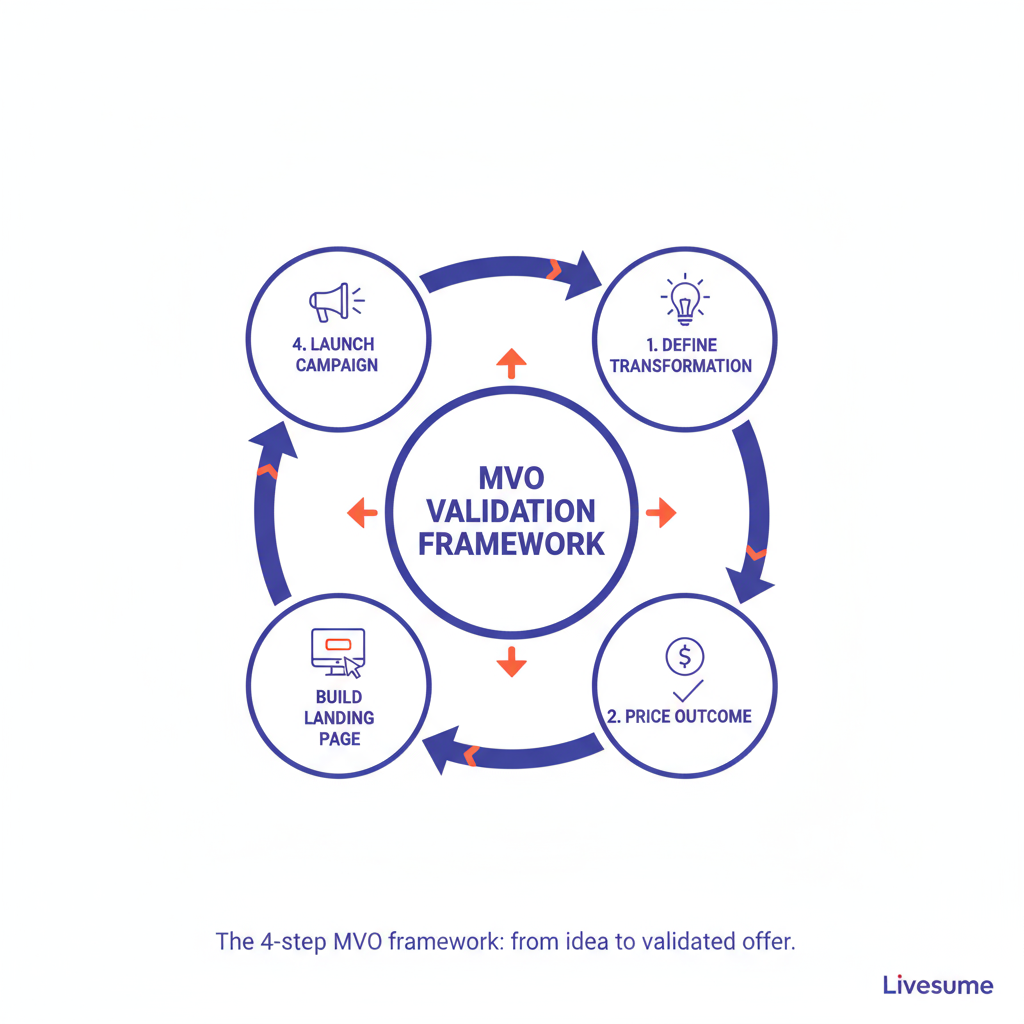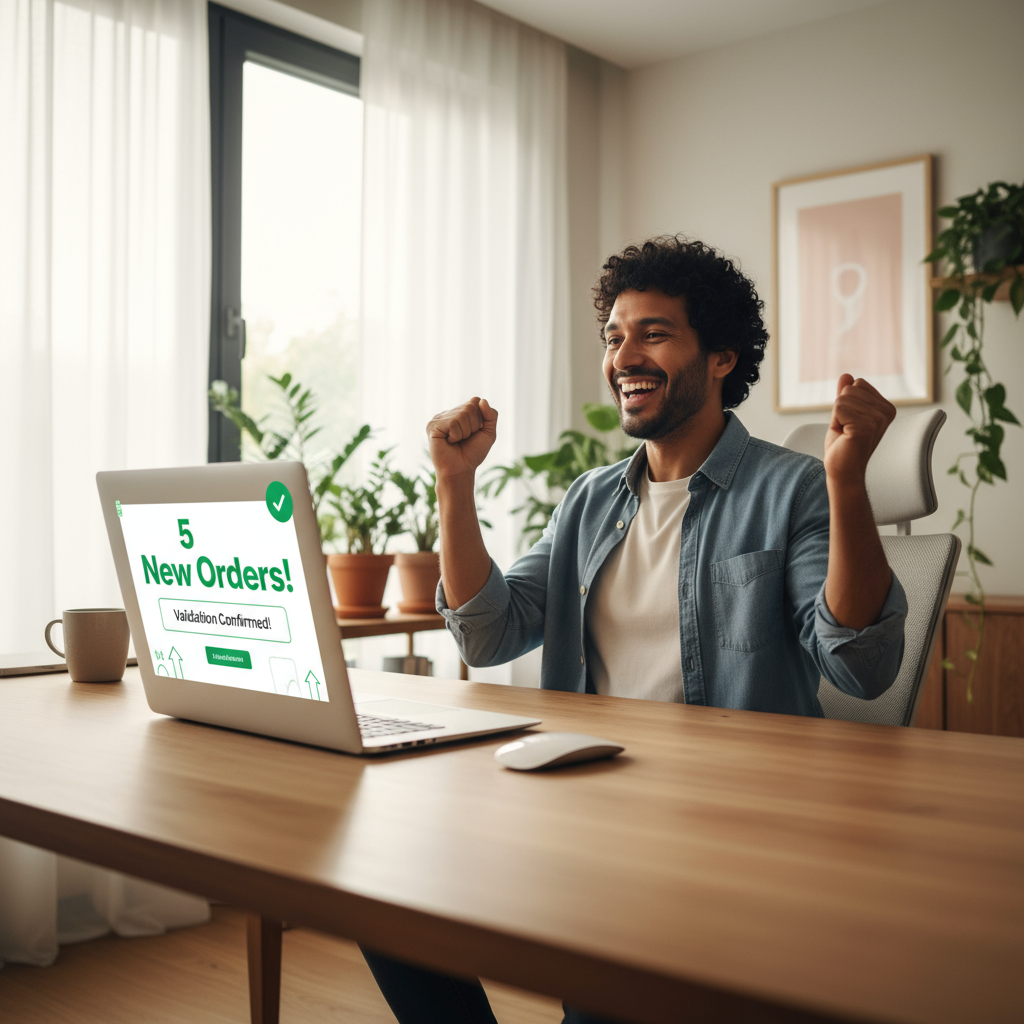You’ve got a brilliant idea for a high-ticket course, a coaching program, or a productized service. But a nagging fear stops you: what if you spend the next three months building it, only to launch to the sound of crickets? This paralysis—the fear of building in the dark—kills more great ideas than any market ever could. We're going to fix that. This guide provides a framework to validate your $5k offer *before* you build it, using just a single, powerful landing page.
Key Takeaways
- Test, Don't Guess: Learn what a Minimum Viable Offer (MVO) is and how it de-risks your next big idea by testing demand with real, paying customers first.
- Focus on Transformation: Shift from selling hours or features to selling a clear, desirable outcome. We'll show you how to define and price it effectively.
- Build Your Validation Engine Fast: Use a simple landing page as your primary tool. You don't need a full website or complex funnel to get your first pre-orders.
- AI-Assisted Launch: Discover how AI tools can help you draft your MVO page copy, create mockups, and get your validation campaign running in a fraction of the time.
- Green-Light Your Idea: Get a clear, data-backed signal (i.e., revenue) that tells you exactly which ideas are worth your time and which ones to drop.

What's a Minimum Viable Offer (And Why Isn't It an MVP)?
You’ve probably heard of a Minimum Viable Product (MVP). It’s the simplest version of a product you can ship to users. But for consultants, coaches, and creators, building even a simple "product" can take months. The Minimum Viable Offer (MVO) comes first. It’s not a product; it's a promise.
An MVO is the smallest, simplest version of your offer that you can present to a potential customer to see if they will pay for it. It’s a single landing page that clearly articulates a transformation, a price, and a call to action—usually a pre-order, a deposit, or a paid strategy call.
The difference is critical. An MVP tests if your product works. An MVO tests if your *idea* sells. It shifts the entire validation process from "Can I build this?" to the far more important question: "Should I?"
Before You Build: The 4-Step MVO Validation Framework
Ready to stress-test your idea? This isn't about theory; it's about action. Follow these four steps to go from a fuzzy concept to a validated offer.
Step 1: Define the Transformation, Not the Deliverables
People don’t buy "10 coaching calls" or "20 video modules." They buy a solution to a painful problem—a transformation. Your first job is to articulate that shift clearly.
- Before: "I'm selling a 12-module course on SEO for small businesses."
- After: "I help small businesses double their organic traffic in 90 days without buying ads."
The second version is an outcome; the first is a list of features. Your MVO must sell the outcome. Get specific. Who is it for? What is the tangible result? What's the timeframe? Nail this, and the rest of your page writes itself.
Step 2: Price the Outcome (and Your Confidence)
Pricing a product that doesn't exist feels tricky, but it’s a core part of the validation process. You need to test if someone will pay a specific price for your promised outcome. A common strategy is to offer a "Founder's Circle" or "Beta Group" discount—typically 30-50% off the final intended price. This creates urgency and rewards early adopters.
For a $5,000 program, you might pre-sell 5-10 beta spots at $2,500. This tests a significant price point and gives you upfront cash to fund the creation process.

Step 3: Build Your Validation Engine: The MVO Landing Page
This is where your idea meets reality. You don't need a full website. You need one, focused professional page that does one job: converting a visitor into a paying customer. At Livesume, we see our users build these validation engines in an afternoon.
Your MVO page should include:
- A Killer Headline: The transformation you defined in Step 1.
- Who It's For: Call out your ideal client directly.
- The Problem: Agitate the pain point you solve.
- The Promised Land: Paint a clear picture of the outcome.
- The "How": Briefly outline the process (e.g., "A 6-week live cohort," "A set of proven templates and 1:1 support").
- The Offer: Detail the beta price, what's included, and any bonuses.
- The Call to Action (CTA): A clear button to "Pre-Order Now" or "Apply for a Spot." This should link to a payment processor like Stripe or an application form.
Ready to Build Your Validation Engine?
Stop wondering if your idea is any good. Use our AI editor to generate a draft of your Minimum Viable Offer page in the next 10 minutes. Turn your concept into a testable asset today.
Build Your MVO Page Now
Step 4: Launch the Validation Campaign & Triage Feedback
Your page is live. Now you need to get the right people to see it. You don't need a massive budget. Start with your existing audience:
- Your Email List: Send a direct, personal email announcing the beta opportunity.
- Social Media: Share your offer where your ideal clients hang out (LinkedIn, Twitter, specific Facebook groups).
- 1-to-1 Outreach: Personally message 10-20 people in your network who are a perfect fit.
The goal isn't just to get sales; it's to get feedback. If people don't buy, ask why. Is the price wrong? Is the outcome unclear? This feedback is pure gold.
How Many Pre-Orders Signal a Green Light?
This isn't an exact science, but here’s a solid rule of thumb: aim for 5-10 pre-orders or paid deposits to validate a high-ticket offer.
Why this range? One or two sales could be a fluke—friends or loyal followers supporting you. But five to ten sales from real customers proves you’ve hit a nerve. It’s a strong signal that a real market demand exists for your solution. Once you hit that number, you can confidently move from validation to building, knowing you’re creating something people have already proven they want.

Frequently Asked Questions
What is a Minimum Viable Offer (MVO)?
An MVO is a focused landing page that presents a core promise and a price to potential customers to validate demand for a service or product *before* it's fully built. It prioritizes selling the idea over shipping a product.
How is an MVO different from an MVP?
An MVO tests the market's willingness to pay for an *idea* (the offer). An MVP tests the user's interaction with a *product* (the functioning software/item). You use an MVO to decide *if* you should build the MVP.
How do you pre-sell a coaching program or course?
Create an MVO landing page detailing the program's transformation, target audience, and structure. Offer a limited number of "beta" or "founder" spots at a significant discount to incentivize early sign-ups and gather feedback.
What should be on a landing page for a product that doesn't exist yet?
Focus on the outcome, not the features. Include a clear headline promising a transformation, details on who it’s for, the problem it solves, a brief outline of the process, a clear beta price, and a pre-order or deposit CTA. Use mockups (made with a tool like Canva) to help visualize the final product.
How many pre-orders do I need to validate an idea?
For a high-ticket item ($1k+), aiming for 5-10 pre-orders is a strong validation signal. This number indicates genuine market interest beyond your immediate network and confirms you're solving a problem people will pay to fix.
Is it okay to sell a product before it's finished?
Yes, as long as you are transparent. Clearly state that it's a pre-order for a "beta program" or "founder's circle." This manages expectations and makes early customers feel like co-creators, not just consumers.
Turn Your Validated Idea Into Your Next Big Thing
The MVO framework transforms business-building from a high-stakes gamble into a calculated experiment. You no longer need to spend months locked away, hoping your idea will work. You can find out in a week.
Here’s your plan:
- Carve out three hours this week. Time-block it now.
- Define the transformation for your best idea. Get it down to a single, powerful sentence.
- Build your one-page MVO using a tool designed for speed, like the Livesume builder.
- Send it to 10 ideal customers. Get feedback, get your first pre-order, and get the green light you've been waiting for.
Stop guessing. Your next big idea is one page away from validation. Go prove it.